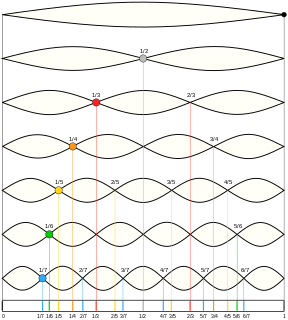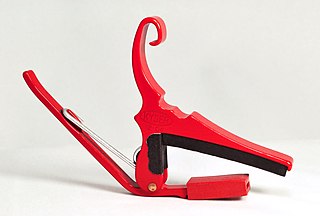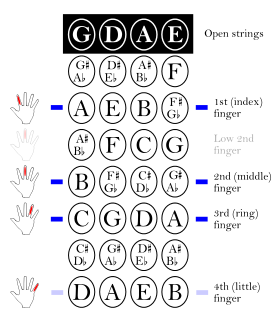
The bassoon is a woodwind instrument in the double reed family that typically plays music written in the bass and tenor clefs, and occasionally the treble. Appearing in its modern form in the 19th century, the bassoon figures prominently in orchestral, concert band, and chamber music literature. The bassoon is a non-transposing instrument known for its distinctive tone colour, wide range, variety of character and agility. Someone who plays the bassoon is called a bassoonist.

The recorder is a woodwind musical instrument in the group known as internal duct flutes—flutes with a whistle mouthpiece. A recorder can be distinguished from other duct flutes by the presence of a thumb-hole for the upper hand and seven finger-holes: three for the upper hand and four for the lower. It is the most prominent duct flute in the western classical tradition.

The violin, also known informally as a fiddle, is a wooden string instrument in the violin family. Most violins have a hollow wooden body. It is the smallest and highest-pitched instrument in the family in regular use. Smaller violin-type instruments exist, including the violino piccolo and the kit violin, but these are virtually unused. The violin typically has four strings tuned in perfect fifths, and is most commonly played by drawing a bow across its strings, though it can also be played by plucking the strings with the fingers (pizzicato) and by striking the strings with the wooden side of the bow.

A harmonic is any member of the harmonic series. The term is employed in various disciplines, including music, physics, acoustics, electronic power transmission, radio technology, and other fields. It is typically applied to repeating signals, such as sinusoidal waves. A harmonic of such a wave is a wave with a frequency that is a positive integer multiple of the frequency of the original wave, known as the fundamental frequency. The original wave is also called the 1st harmonic, the following harmonics are known as higher harmonics. As all harmonics are periodic at the fundamental frequency, the sum of harmonics is also periodic at that frequency. For example, if the fundamental frequency is 50 Hz, a common AC power supply frequency, the frequencies of the first three higher harmonics are 100 Hz, 150 Hz, 200 Hz and any addition of waves with these frequencies is periodic at 50 Hz.
An nth characteristic mode, for n > 1, will have nodes that are not vibrating. For example, the 3rd characteristic mode will have nodes at
L and
L, where L is the length of the string. In fact, each nth characteristic mode, for n not a multiple of 3, will not have nodes at these points. These other characteristic modes will be vibrating at the positions
L and
L. If the player gently touches one of these positions, then these other characteristic modes will be suppressed. The tonal harmonics from these other characteristic modes will then also be suppressed. Consequently, the tonal harmonics from the nth characteristic modes, where n is a multiple of 3, will be made relatively more prominent.

A transposing instrument is a musical instrument whose music is recorded in staff notation at a pitch different from the pitch that actually sounds. A written middle C on a transposing instrument produces a pitch other than middle C, and that pitch identifies the interval of transposition when describing the instrument. For example, a written C on a B♭ clarinet sounds a concert B♭.

Sweep picking is a guitar playing technique. When sweep picking, the guitarist plays single notes on consecutive strings with a 'sweeping' motion of the pick, while using the fretting hand to produce a specific series of notes that are fast and fluid in sound. Both hands essentially perform an integral motion in unison to achieve the desired effect.
In guitar music, especially electric guitar, a power chord Play (help·info) is a colloquial name for a chord that consists of the root note and the fifth. Power chords are commonly played on amplified guitars, especially on electric guitar with distortion. Power chords are a key element of many styles of rock and especially in heavy metal, and punk rock.

A capo is a device a musician uses on the neck of a stringed instrument to shorten the playable length of the strings, hence raising the pitch. It is a common tool for players of guitars, mandolins, mandolas, banjos, ukuleles and bouzoukis. The word derives from the Italian capotasto, which means the nut of a stringed instrument. The earliest known use of capotasto is by Giovanni Battista Doni who, in his Annotazioni of 1640, uses it to describe the nut of a viola da gamba. The first patented capo was designed by James Ashborn of Wolcottville, Connecticut.

A chord, in music, is any harmonic set of pitches consisting of two or more notes that are heard as if sounding simultaneously.
The dulzaina or dolçaina is a Spanish double reed instrument in the oboe family. It has a conical shape and is the equivalent of the Breton bombarde. Often replaced by an oboe or double reeded clarinet, as seen in Armenian and Ukrainian folk music.
A multiphonic is an extended technique on a monophonic musical instrument in which several notes are produced at once. This includes wind, reed, and brass instruments, as well as the human voice. Multiphonic-like sounds on string instruments, both bowed and hammered, have also been called multiphonics, for lack of better terminology and scarcity of research.

In music, a barre chord is a type of chord on a guitar or other stringed instrument, that the musician plays by using one or more fingers to press down multiple strings across a single fret of the fingerboard.
The bowed string instrument musical technique bariolage involves "the alternation of notes on adjacent strings, one of which is usually open", exploiting "the individual timbre of the various strings." This may involve quick alternation between a static note and changing notes that form a melody either above or below the static note. The static note is usually an open string note, which creates a highly resonant sound. "Bariolage" is a nineteenth-century term for an eighteenth-century violin technique, the mechanics of which are not discussed by nineteenth-century writers. The usual bowing technique required, which also may be used separately from bariolage, is called ondulé in French or ondeggiando In Italian. However, it may also be executed with separate bow strokes. In bluegrass fiddling the technique is known as "cross-fingering". Perhaps looking back on what he considered an earlier, less advanced time, one pedagogue explains that
The name bariolage is given to the kind of passage which presents the appearance of disorder and oddness, in that the notes are not played in succession on the same string where one would expect this or when the notes e2, a1, d1, are played not on the same string but alternately with one stopped finger and the open string, or else finally when the open string is played in a position where a stopped note would normally be required.

Guitar tunings assign pitches to the open strings of guitars, including acoustic guitars, electric guitars, and classical guitars. Tunings are described by the particular pitches denoted by notes in Western music. By convention, the notes are ordered from lowest-pitched string to highest-pitched.
In music, fingering, or on stringed instruments stopping, is the choice of which fingers and hand positions to use when playing certain musical instruments. Fingering typically changes throughout a piece; the challenge of choosing good fingering for a piece is to make the hand movements as comfortable as possible without changing hand position too often. A fingering can be the result of the working process of the composer, who puts it into the manuscript, an editor, who adds it into the printed score, or the performer, who puts his or her own fingering in the score or in performance.

Playing the violin entails holding the instrument under the chin, supported by the left shoulder. The strings are sounded either by drawing the bow across them (arco), or by plucking them (pizzicato). The left hand regulates the sounding length of the strings by stopping them against the fingerboard with the fingers, producing different notes.

Chuck Wayne was a jazz guitarist. He came to prominence in the 1940s, and was among the earliest jazz guitarists to play in the bebop style. Wayne was a member of Woody Herman's First Herd, the first guitarist in the George Shearing quintet, and Tony Bennett's music director and accompanist. He developed a systematic method for playing jazz guitar.

Tablature is a form of musical notation indicating instrument fingering rather than musical pitches.
Brass Tablature is a rather rare form of music notation that applies to all brass instruments, but is most commonly found written for trumpet. It consists of lines with partials, and numbers representing valve or slide positions.

On a string instrument, position is the relative location of the hand on the instrument's neck, indicated by ordinal numbers. Fingering, independent of position, is indicated by numbers, 1-4, and string is indicated by Roman numerals, I-IV. Different positions on the same string are reached through shifting.















